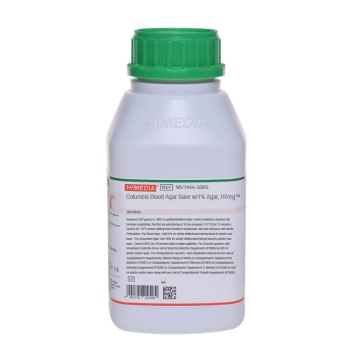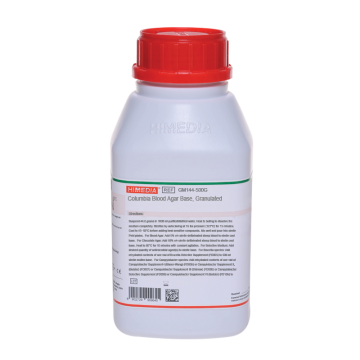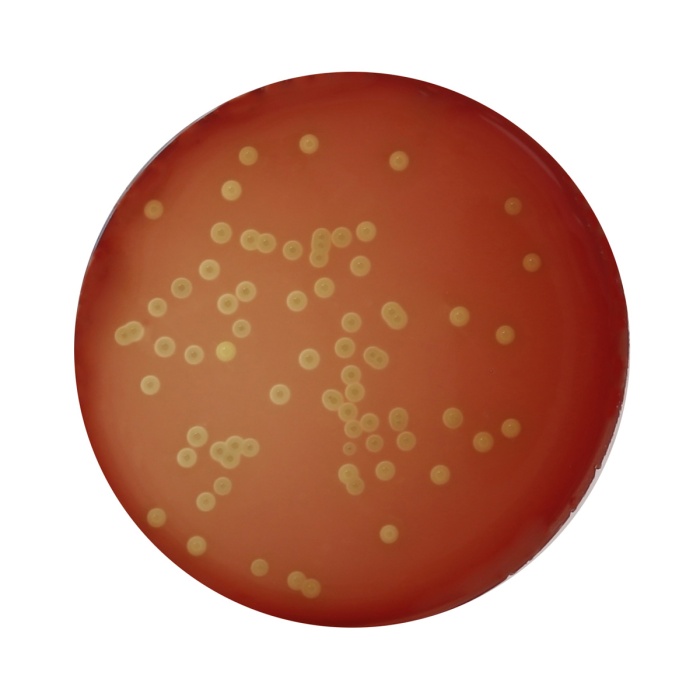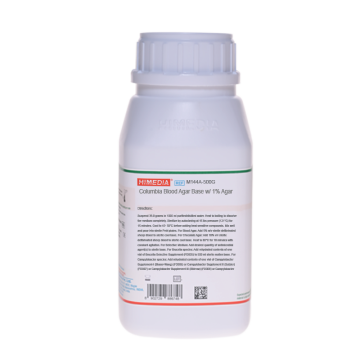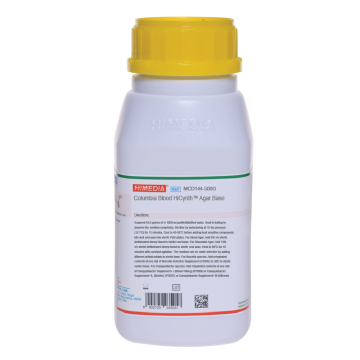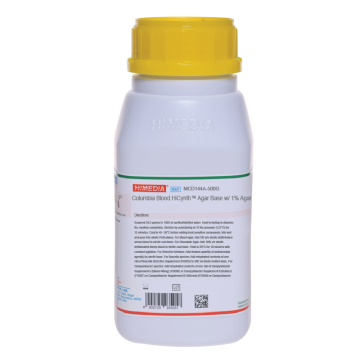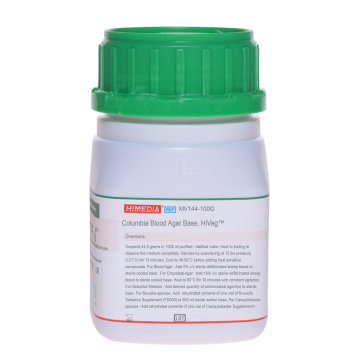 Your enquiry has been submitted
Your enquiry has been submitted
Columbia Blood Agar Base
Intended Use
Recommended for selective detection and enumeration of Campylobacter species from food chain. The composition and performance criteria of this medium are as per the specifications laid down in ISO 10272-1:2017, ISO 10272-2:2017 and ISO 11133:2014 /Amd. 2:2020 (Ε).
Composition**
ISO Specification - Columbia Blood Agar
| Ingredients | g/L |
|---|---|
| Enzymatic digest of animal tissues | 23.000 |
| Starch soluble | 1.000 |
| Sodium chloride | 5.000 |
| Agar | 8.00 to 18.00 |
Supplements to be added after autoclaving
| Blood | 50ml |
| Final pH (at 25°C) | 7.4±0.2 |
M144I- Columbia Blood Agar Base
| Ingredients | g/L |
|---|---|
| Peptone # | 23.000 |
| Starch soluble | 1.000 |
| Sodium chloride | 5.000 |
| Agar | 15.000 |
5% v/v sterile defibrinated sheep blood.
| Blood | 50ml |
| Final pH (at 25°C) | 7.4±0.2 |
**Formula adjusted, standardized to suit performance parameters # Enzymatic digest of animal tissues
Directions
Suspend 44.0 gram of in 1000 ml purified/distilled water. Heat to boiling to dissolve the medium completely. Sterilize by autoclaving at 15 lbs pressure (121°C) for 15 minutes. Cool to 44-47°C. Aseptically add 5% v/v sterile defibrinated sheep blood. Mix well and pour into sterile Petri plates.
Principle And Interpretation
Campylobacters are carried in the intestinal tract of animal and therefore contaminate foods of animal origin (1). Campylobacter causes intestinal upset or abortion in animals. It is also one of the most important causes of human gastroenteritis, particularly in children. Columbia Blood Agar Base was devised by Ellner et al (2) and recommended by the ISO Committee (3-5) for detection and enumeration of Campylobacter spp.
This medium contains peptone which supports rapid and luxuriant growth of fastidious and non-fastidious organisms. Also, this medium promotes typical colonial morphology; better pigment production and more sharply defined haemolytic reactions Starch serves as an energy source and also neutralizes toxic metabolites. Sheep blood permits the detection of haemolysis and also provides heme (X factor) which is required for the growth of many bacteria. However it is devoid of V factor (Nicotinamide adenine dinucleotide) and hence Haemophilus influenzae which needs both the X and V factors, will not grow on this medium. As this medium have a relatively high carbohydrate content, beta-haemolytic Streptococci may exhibit a greenish haemolytic reaction which may be mistaken for the alpha haemolysis. Carry out confirmatory tests of all the colonies.
Type of specimen
Food samples
Specimen Collection and Handling:
Processesing: (3-4)
Test portion and initial suspension:
Selective Enrichment A: To prepare the initial suspension, combine a quantity of 10g or 10ml of the test portion with 90ml of the enrichment medium Bolton Broth (M1592) from cooked and frozen food. Incubate the initial suspension in a microaerobic atmosphere at (37±1)°C for 4-6 hours and then at (41.5±1)°C for 44±4 hours.
Selective Enrichment B:
To prepare the initial suspension, combine a quantity of 10g or 10ml of the test portion with 90ml of the enrichment medium Preston Broth (M8991) from raw meats or raw milk. Incubate the initial suspension in a a microaerobic atmosphere at (41.5±1)°C for 24 hours ± 2 hours.
Plating out :
Using the culture obtained in the enrichment medium, inoculate with a sterile 10 µl loop on the surface of mCCD Agar (M887I). Incubate the plates at (41.5±1)°C in a microaerobic atmosphere for 44 ± 4 hours.
Selective Enrichment C:
Directly swab or streak on mCCD agar from caecal or faecal samples by using a loop or a sterile swab and second medium can be optional. Incubate the plates at (41.5±1)°C in a microaerobic atmosphere for 44 ± 4 hours.
Selection of colonies for confirmation :
Select the colonies from mCCD Agar (M887I) and streak it on Columbia Blood Agar Base. Incubate it at (41.5 ±1)°C for 24-48 hours in microaerobic condition.
Confirmation:
Biochemical and serological tests are performed for confirmation.
Warning and Precautions :
Read the label before opening the container. Wear protective gloves/protective clothing/eye protection/face protection. Follow good microbiological lab practices while handling specimens and culture. Standard precautions as per established guidelines should be followed while handling specimens. Safety guidelines may be referred in individual safety data sheets.
Limitations :
- Individual organisms differ in their growth requirement and may show variable growth patterns on the medium.
- Each lot of the medium has been tested for the organisms specified on the COA. It is recommended to users to validate the medium for any specific microorganism other than mentioned in the COA based on the user's unique requirement.
- For further confirmation of Campylobacter oxidase, catalase, hippurate test and indoxyl acetate hydrolysis should be carried out.
Performance and Evaluation
Performance of the medium is expected when used as per the direction on the label within the expiry period when stored at recommended temperature.
Quality Control
Appearance Cream to yellow homogeneous free flowing powder
Gelling Firm, comparable with 1.5% Agar gel
Colour and Clarity of prepared medium Basal medium: Light amber coloured clear to slightly opalescent gel. After addition of 5% w/v sterile defibrinated blood: Cherry red coloured opaque gel forms in Petri plates
Reaction Reaction of 4.4% w/v aqueous solution at 25°C. pH: 7.3±0.2
pH 7.10-7.50
Cultural Response Productivity: Cultural characteristics observed with added 5% w/v sterile defibrinated blood, after an incubation at 41.5±1°C for 24 to 48 hours in microaerobic conditions. Recovery rate is considered as 100% for bacteria growth on Reference Medium - previously validated Blood Agar.
| Organism | Inoculum | Growth | Recovery |
|---|---|---|---|
| Productivity | |||
| Campylobacter coli ATCC 33559 (00004*) | 50-100 | Good-luxuriant | >=70% |
| Campylobacter jejuni ATCC 33291 (00005*) | 50-100 | Good-luxuriant | >=70% |
| Campylobacter jejuni ATCC 29428 (00156*) | 50-100 | Good-luxuriant | >=70% |
Key: (*) - Corresponding WDCM numbers
Storage and Shelf Life
Store between 10-30°C in a tightly closed container and the prepared medium at 2-8°C. Use before expiry date on the label. On opening, product should be properly stored dry, after tightly capping the bottle in order to prevent lump formation due to the hygroscopic nature of the product. Improper storage of the product may lead to lump formation. Store in dry ventilated area protected from extremes of temperature and sources of ignition Seal the container tightly after use. Product performance is best if used within stated expiry period.
Disposal
User must ensure safe disposal by autoclaving and/or incineration of used or unusable preparations of this product. Follow established laboratory procedures in disposing of infectious materials and material that comes into contact with sample must be decontaminated and disposed of in accordance with current laboratory techniques (6,7).
Reference
- Salfinger Y. and Tortorello M. L., (Eds.), 2015, Compendium of Methods for the Microbiological Examination of Foods, 5th Ed., APHA, Washington, D.C.
- Ellner P. P., Stoessel C. J., Drakeford E. and Vasi F., 1966, Am. J. Clin. Pathol., 45:502.
- Microbiology of the food chain - Horizontal method for detection and enumeration of Campylobacter 1: Detection method. International Organization for Standardization (ISO), 10272-1:2017(E).
- Microbiology of food chain-Horizontal method for detection and enumeration of Campylobacter spp. — Part 2 International Organization for Standardization (ISO), 10272-2:2017(E).
- Microbiology of food,animal feeding stuffs and water- Preparation, production,storage and performance testing of culture media, EN ISO 11133:2014/Amd. 2 :2020 (Ε) .
- Isenberg, H.D. Clinical Microbiology Procedures Handbook 2nd Edition.
- Jorgensen, J.H., Pfaller, M.A., Carroll, K.C., Funke, G., Landry, M.L., Richter, S.S and Warnock., D.W. (2015) Manual of Clinical Microbiology, 11th Edition. Vol. 1.
| Product Name | Columbia Blood Agar Base |
|---|---|
| SKU | M144I |
| Product Type | Regular |
| Physical Form | Powder |
| Origin | Animal |
| Packaging type | HDPE |
| References | 1. American Public Health Association, Standard Methods for the Examination of Dairy Products, 1978, 14th Ed., Washington D.C 2.Ellner P. P., Stoessel C. J., Drakeford E. and Vasi F., 1966, Am. J. Clin. Pathol., 45:502 3.Isenberg, H.D. Clinical Microbiology Procedures Handbook. 2nd Edition4.Jorgensen, J.H., Pfaller, M.A., Carroll, K.C., Funke, G., Landry, M.L., Richter, S.S and Warnock., D.W. (2015) Manual of Clinical Microbiology, 11th Edition. Vol. 1. 5.Microbiology of food chain-Horizontal method for detection and enumeration of Campylobacter spp. International Organization for Standardization (ISO), 10272-2:2017(E) 6.Salfinger Y. and Tortorello M. L., (Eds.), 2015, Compendium of Methods for the Microbiological Examination of Foods, 5th Ed., APHA, Washington, D.C. |
| Customized Product Available | No |




